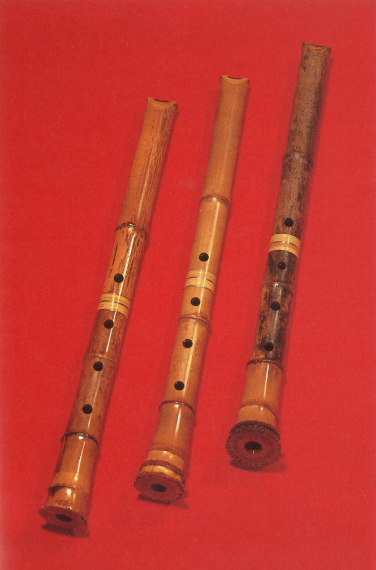quotation:The Encyclopedia of Musical Instruments the SHAKUHACHI
Tokyo Ongaku-sha Co.Ltd 1990
引用:楽器の事典 尺八
(株)東京音楽社 1990年発行
FOREWORD
The shakuhachi (five-holed horizontal bamboo flute) ― this is a very simple instrument played without a reed. It is much simpler in its construction than the baroque recorder (blockfloete) (Photograph 1) . Though the recorder has at least one key worked by the principle of the lever and the spring, the shakuhachi has no such mechanical device. Regardless of the length of the instrument, the shakuhachi usually has only five finger holes, four on the front and one on the back. Every finger hole is closed directly by the finger tips using the area of the finger prints. Thus, it is possible to produce more subtle and delicate intervals and tone colors than those of Western woodwind instruments. Shakuhachi musicproduces a peculiar tone with an atmosphere of its own that neither the flute nor the clarinet can ever realize, because the shakuhachi is a very mysterious instrument with a rich expressive power.
It is generaly said that the process of constructing a recorder requires at least three workers, from the cutting down of the wood that is the raw material to the final completion of the instrument. In contrast, in the case of the shakuhachi, one shakuhachi maker can accomplish the entire process of the shakuhachi construction, from cutting down of the material, bamboo, to its completion, as he would like. Thus, the reason why every shakuhachi has its own peculiar character is that it is constructed completely according to one maker's plan and design.
This collaborative book was writtern as a result of the research and discussion of the following members : Kitahara Ikuya, who is trying to assimilate the old traditions of shakuhachi construction with new innovations, while refining his skills as a shakuhachi player ; Matsumoto Misao, Associate Professor of Hyōgo University of Teacher's Education, who is groping for ways to introduce traditional music into music education in the schools ; and Matsuda Akira, Associate Professor of Shimane University, Department of Education who is studying and composing shakuhachi music. Dr. Tanimura Kō, Professor of Osaka University, Department of Literature and former President of the Musicological Society of Japan, who has gained great insight into ethnic music, while pursuing the history of music and aesthetics of music as his major field, and Kitahara Kōzō, present master of Kitahara Seikadō in Kyoto, one of the most outstanding shakuhachi makers at the present time, gave us wholehearted advice and assistance as supervisors. Further, we were assisted in various ways by three young researchers, Yoshimura Nobumi, Kizu Itsumi, and Yasui Manami.
(Photograph 1) Completed shakuhachi
left : Tanimera Kō's shakuhachi
middel : Matsumoto Masao's shakuhachi
right : Matsuda Akira' shakuhachi

quotation:The Encyclopedia of Musical Instruments the SHAKUHACHI
Tokyo Ongaku-sha Co.Ltd
引用:楽器の事典 尺八
(株)東京音楽社


